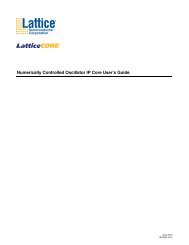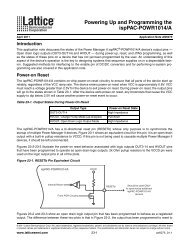DS1036 - Platform Manager Data Sheet - Lattice Semiconductor
DS1036 - Platform Manager Data Sheet - Lattice Semiconductor
DS1036 - Platform Manager Data Sheet - Lattice Semiconductor
Create successful ePaper yourself
Turn your PDF publications into a flip-book with our unique Google optimized e-Paper software.
57<br />
<strong>Platform</strong> <strong>Manager</strong> <strong>Data</strong> <strong>Sheet</strong><br />
Modes of Operation<br />
Each slice is capable of four modes of operation: Logic, Ripple, RAM, and ROM. The slice in the PFF is capable of<br />
all modes except RAM. Table 15 lists the modes and the capability of the slice blocks.<br />
Table 15. Slice Modes<br />
Logic Ripple RAM ROM<br />
PFU Slice LUT 4x2 or LUT 5x1 2-bit Arithmetic Unit SP 16x2 ROM 16x1 x 2<br />
PFF Slice LUT 4x2 or LUT 5x1 2-bit Arithmetic Unit N/A ROM 16x1 x 2<br />
Logic Mode: In this mode, the LUTs in each slice are configured as 4-input combinatorial lookup tables (LUT4). A<br />
LUT4 can have 16 possible input combinations. Any logic function with four inputs can be generated by programming<br />
this lookup table. Since there are two LUT4s per slice, a LUT5 can be constructed within one slice. Larger<br />
lookup tables such as LUT6, LUT7, and LUT8 can be constructed by concatenating other slices.<br />
Ripple Mode: Ripple mode allows the efficient implementation of small arithmetic functions. In ripple mode, the following<br />
functions can be implemented by each slice:<br />
Addition 2-bit<br />
Subtraction 2-bit<br />
Add/Subtract 2-bit using dynamic control<br />
Up counter 2-bit<br />
Down counter 2-bit<br />
Ripple mode multiplier building block<br />
Comparator functions of A and B inputs<br />
- A greater-than-or-equal-to B<br />
- A not-equal-to B<br />
- A less-than-or-equal-to B<br />
Two additional signals, Carry Generate and Carry Propagate, are generated per slice in this mode, allowing fast<br />
arithmetic functions to be constructed by concatenating slices.<br />
RAM Mode: In this mode, distributed RAM can be constructed using each LUT block as a 16x2-bit memory.<br />
Through the combination of LUTs and slices, a variety of different memories can be constructed.<br />
The <strong>Platform</strong> <strong>Manager</strong> design tool supports the creation of a variety of different size memories. Where appropriate,<br />
the software will construct these using distributed memory primitives that represent the capabilities of the PFU.<br />
Table 16 shows the number of slices required to implement different distributed RAM primitives. Figure 42 shows<br />
the distributed memory primitive block diagrams. Dual port memories involve the pairing of two slices. One slice<br />
functions as the read-write port, while the other companion slice supports the read-only port. For more information<br />
on RAM mode in the FPGA section, please see details of additional technical documentation at the end of this data<br />
sheet.<br />
Table 16. Number of Slices Required For Implementing Distributed RAM<br />
SPR16x2 DPR16x2<br />
Number of Slices 1 2<br />
Note: SPR = Single Port RAM, DPR = Dual Port RAM









